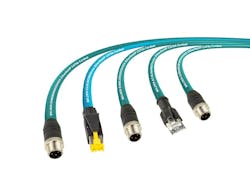New process device profiles have been added by ODVA to the EtherNet/IP specification to provide end users with another tool to help optimize plant operations. According to ODVA, the new process device profiles “provide a standard format for process variables and diagnostics across an array of devices for smoother vendor interoperability and easier DCS and PLC data integration from EtherNet/IP-enabled field devices.”
ODVA says device profiles are available for Coriolis flow, electromagnetic flow, vortex flow, standard pressure and scaled pressure devices. “Process end users can now take advantage of EtherNet/IP devices with better communication of critical diagnostics such as NAMUR NE 107 status signals and improved alignment with the Process Automation Device Information Model (PA-DIM),” says ODVA.
PA-DIM—a joint standard between FieldComm Group, ISA100 WCI, NAMUR, ODVA, OPC Foundation, PI, VDMA, and ZVEI—represents information from process devices in a standardized way for easier access.
In addition to exposing measurement values and the quality or status of those values, EtherNet/IP process device profiles can also simulate measurement values. This enables critical safety functions such as partial stroke tests in valves to take place without interfering with the process data. The standard formatting of live process variables, data totals, and diagnostics that process device profiles provide also increases vendor interoperability for end users given that the information will be the same across EtherNet/IP devices, regardless of vendor.
The addition of process device profiles adds to the process automation capability of EtherNet/IP, including the ability to use the Ethernet-APL physical layer. Ethernet-APL is a combination of Single Pair Ethernet (IEEE 802.3cg-2019, 10BASE-T1L), engineered power, intrinsic safety (IEC 60079, 2-WISE), and Type A fieldbus cable (IEC 61158-2, for intrinsic safety) that is able to reach 1,000 meter distances and speeds of 10Mbit/s.
According to ODVA, EtherNet/IP process device profiles are comprised of process measurement value objects that track cumulative data totals such as total flow and process device diagnostics objects that enable plant operators and maintenance personnel easier access to additional device and process status information. These process device profiles help convert sensor signals and actuator positions into valuable information that enables action to be taken to improve product quality and operational efficiency.
Process device profiles can also help evaluate the reliability of the measuring signal and aid in preventing plant shutdowns by identifying premature device failures, says ODVA. As an example, the process totalized value object can track total device usage and device health can be inferred from the process measurement value and diagnostics objects. This allows users to shift from time-based maintenance to condition-based maintenance, potentially saving devices from unnecessarily being replaced during plant shutdowns while identifying other devices that are failing prematurely, which can reduce both unnecessary maintenance costs and potential downtime.


